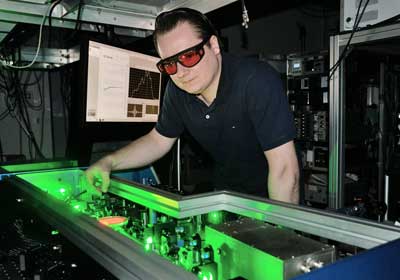| Posted: Sep 23, 2017 |
Dancing electrons lose the race
(Nanowerk News) Atoms emit electrons when a material is irradiated with light at a sufficiently high frequency. Previously, physics had assumed that the motion of these photoelectrons is determined by the properties of the material.
|
|
In a new study, physicists at Bielefeld University have shown that it is the interplay of the electrons within the atom that is decisive. ‘Dancing’ electrons orbit the nucleus of the atom and require more time than other electrons that shoot out in straight lines. The Bielefeld researchers are the first in the world to confirm the existence of this delay mechanism in a solid.
|
|
The study has been published in Science ("Angular momentum induced delays in solid state photoemission enhanced by intra-atomic interactions"). To carry out this research, the experimenters cooperated closely with colleagues working in theoretical physics at the Donostia International Physics Center (DIPC) at the University of the Basque Country (San Sebastian, Spain).
|
 |
| To emit electrons from the semiconductor crystal, researchers in Bielefeld bombard it with ultra-short laser pulses. (Photo: Bielefeld University)
|
|
Albert Einstein received his Nobel Prize for explaining the photoelectric effect: light transfers energy to electrons in the form of energy packets called light quanta or photons. If the light quanta have sufficiently high energy, the electron can leave the material. This is known as the ‘photo effect’. At lower light quanta energies, this effect forms, for example, the basis for generating electricity with solar cells. It is of fundamental importance for many further technological applications.
|
|
‘For our study on electron emission, we carried out a sort of race between electrons with different starting conditions,’ says Professor Dr. Walter Pfeiffer. His and Professor Dr. Ulrich Heinzmann’s team at Bielefeld University’s Chair for Molecular and Surface Physics apply the method of time-resolved laser spectroscopy: ‘We use a laser beam and bombard a semiconductor crystal with ultra-short laser pulses. This starts the race. We time the electron arrival with a very intensive second light pulse and determine the sequence in which the electrons leave the material.’ This requires a very high time resolution.
|
|
‘We are talking about extremely tiny time intervals here,’ says Pfeiffer. The methodology used belongs to the emerging field of attosecond laser technology. The arrival of the electrons is determined with a resolution of approximately ten attoseconds. An attosecond is a billionth of a billionth of a second. The relation of the time resolution in the experiment to one second is roughly equivalent to the relation of one second to the age of the universe.
|
|
The laser experiments produced an unexpected result: ‘What are actually the faster electrons arrive later,’ says Pfeiffer. ‘That’s because they are initially still in orbit around the atomic nucleus before they make their way to the surface of the material and are emitted. Hence, electrons that dance round the atomic nucleus lose the race.’ Other electrons, according to Pfeiffer, fly straight out of the atom. ‘That’s like a rocket that is launched straight into space without first orbiting the earth.’ Because it is actually the slower electron taking the direct path that wins the race.
|
|
Whether and how long an electron dances round the nucleus depends on its starting conditions. ‘The semiconductor material that we used offers four photoemission channels with different starting conditions,’ says Pfeiffer. It was comparing these four channels that permitted, according to Pfeiffer, the far-reaching conclusions of the study that is now being published.
|
|
‘Our observation that fast electrons can require more time to leave the solid makes it necessary to modify the previous theoretical assumption used to describe the photo effect,’ says the experimental physicist Pfeiffer. ‘New theoretical models of photoemission from solids will have to take into account the interplay between the electrons in the atom that emits the photoelectrons. Hence, the dance of the electrons after excitation needs to be treated correctly.’
|
|
The cooperation with the theoretical physicists working in the Donostia International Physics Center (DIPC) at the University of the Basque Country (San Sebastian, Spain) made a decisive contribution to interpreting the Bielefeld experiments. The DIPC worked out how the electrons moved, both within the atom and in the semiconductor crystal.
|

